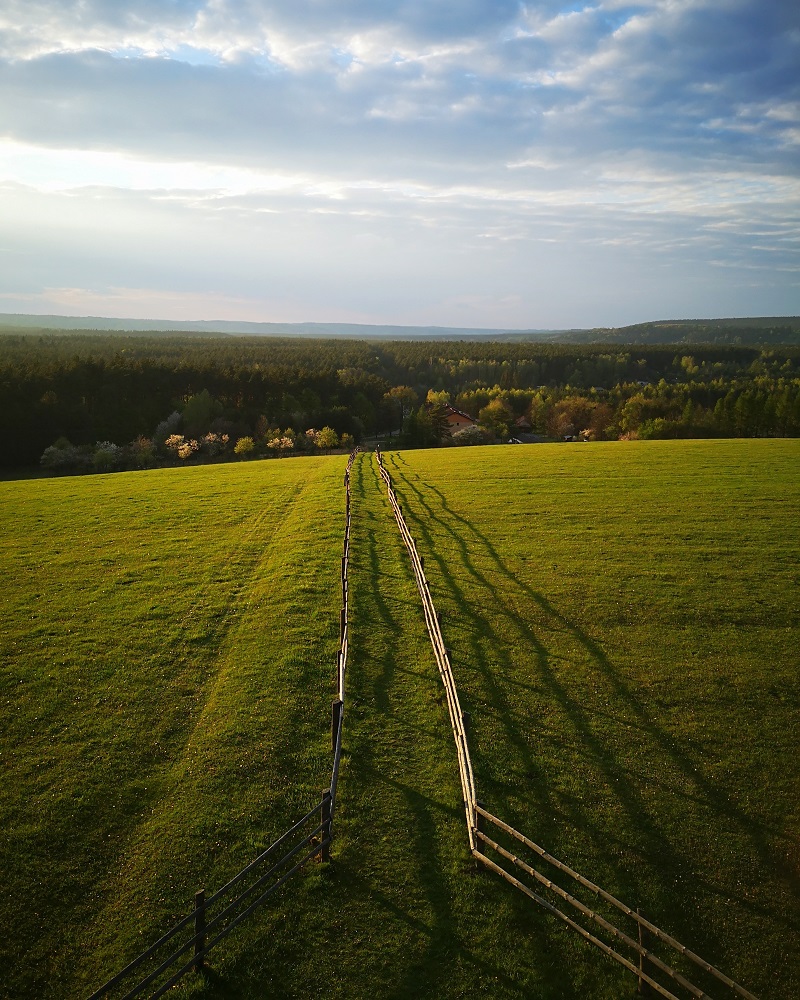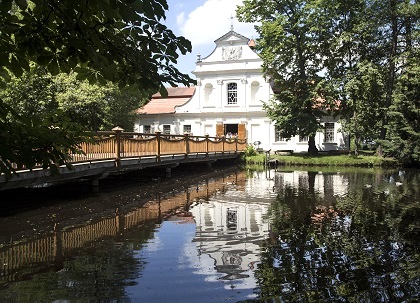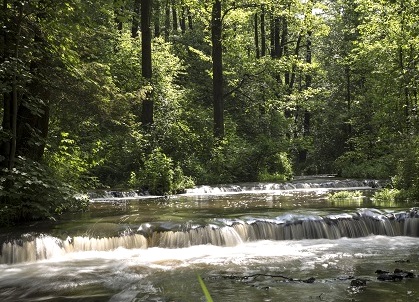Imagine a green wavy land, mighty oaks and stately beeches. Singing of birds, horses grazing freely among the forest backwoods, a steady pulse of nature. Can you feel this peace? Now sit back and we'll tell you what the water is humming about in the streams of Roztocze.

THE LAND OF FIR, BEECH AND TARPAN
Roztocze National Park is located in the southern part of the Lublin Voivodeship, about 100 km from Lublin and 30 km from Zamość. As much as 94% of its area consists of forests, which makes it the most forested park in Poland. The uniqueness of this area was noticed already in the 16th century. At the behest of the Chancellor and Grand Crown Hetman Jan Zamoyski, a special zone was was created there, which was a mix of an animal preserve and a hunting area. Fortunately, nowadays nobody hunts here anymore, unless it's with a camera - and it is not difficult to get nice shots. Due to the richness of the local flora, Roztocze National Park is home to 3630 species of animals, with the most famous being the Polish Konik, a species of horse. There are also deer, elks, roe deer, and wild boars, as well as wolves and lynxes. Fans of birdwatching will have a chance to observe a black stork, lesser spotted eagle, white-tailed eagle or Ural owl.
It's best to start the adventure in the Roztocze National Park with a visit to the Center for Education and Museum in Zwierzyniec, where the tourists can enjoy an interesting nature exhibition. A number of useful tips and interesting information can be obtained by visiting the Tourist Information Centre located there. This is the place where you can get the necessary maps and buy tickets for nature paths.
The cognitive pathways begin by the Center for Education and Museum. One of the most popular leads to Beech Mountain. After crossing the magnificent wooden gate, which resembles a portal to the kingdom of nature, a unique forest staircase leads to the top. The climb is rewarded with a wonderful view of the picturesque mosaic of Roztocze fields and forests. Further on, the path leads us to the village of Sochy, where it ends near the cemetery commemorating the pacification of the village in 1943. The length of the entire route is about 2.5 km. A VISIT TO THE POLISH KONIK
A VISIT TO THE POLISH KONIK
Echo Ponds are one of the favorite places for tourists visiting the Roztocze National Park. The location of the water bodies in the valley of the Świerszcz stream, among the forests and at the foot of the dunes is conducive to full relaxation, especially since a sandy beach and swimming area are available. The areas in the vicinity of the ponds are a refuge for the Polish Koniks, which we can observe from the observation tower. It's easy to get there by car, but there are better solutions. The best and also the most beautiful is walking the "Path along the Dune to the Echo Ponds", which starts at the Center for Education and Museum in Zwierzyniec. The route is 1.7 km long. The cyclists going to the beach are recommended the "Path to the Echo Ponds", which starts near the historic brewery, also in Zwierzyniec. The distance is similar. Thanks to the facilities used, the path is also available for people with disabilities and families with prams.
Another chance for a close encounter with the Polish Koniks is a walk through an over a kilometer-long cognitive trail to Biała Góra. The route begins at the parking lot of the Roztocze Science and Education Center. However, we can also start our journey at an unpaved car park by the Zwierzyniec-Józefów road. The path crosses the Konik's refuge area, so moving is only possible through a designated path. The nine-meter observation tower gives the opportunity of better observation of the horses and white-backed cattle raised here. A great panorama of the area is an additional treat. It is also an ideal place for bird watching. The path is not available for bicycles.
The area around the Echo Ponds is also the beginning of another cognitive path "To Piaseczna Góra", leading to the viewpoint especially liked by the bird watchers. After enjoying the captivating view on the area, we can start our journey back through the forest meadow and pine forest. The 3.2 km long path ends in Zwierzyniec.
.jpg) THE TWO FLORIANS
THE TWO FLORIANS
Florianka is another of the charming attractions of the Roztocze National Park. It's a former forest fee tail estate that appeared on the maps in the first half of the 19th century. A forester's lodge, two gamekeepers' cottages, and a grange were established here. The name of the settlement comes from the famous 14th century knight - Florian the Grey, whom the Zamoyski family considered his great ancestor. According to the legend, it was in this area that the knight was attacked by a giant bear. Janka, the knight's sister, treated his wounds in the shadow of a magnificent oak. Was it the truth? Apparently only one witness of those events survived to this day, the Florian Oak named after the great knight. Currently, Florianka is home to the Forest Chamber which shows the lives of the foresters and their families in the interwar period, together with the Stable Breeding Center of the Polish Konik. Two cognitive paths, dendrological and landscape, have been marked out here. About a kilometer long dendrological path includes several dozen specimens of trees and shrubs, which were planted by foresters of the Zamość Estate in the local forest nurseries. Full knowledge of Florianka's treasures is guaranteed by a walk along the landscape path (1.2 km). The walk begins at the Forest Chamber and continues through the area of the former farm to the Stable Breeding Center. It is here that we can take a close look at the Polish Koniks, as well as the native variety of sheep - the Uhrussian sheep. What is the best way to get to Florianka? Preferably by bike. The Rybakówka - Florianka - Górecko Stare route leads from the Center for Education and Museum (15 km).
MEETING WITH THE HISTORY
Roztocze National Park is a place with an interesting past. History lovers are particularly recommended to visit two cognitive paths - to the Polak Hill and to Wojda. The two-kilometer historical and nature path to the Polak Hill refers to the January Uprising and the battles fought here. It's also a great place to observe the panorama of the Sandomierz Basin and the edge of Roztocze. The beginning of the path is located west of Zwierzyniec, at a parking lot by the national road No. 858 leading to Biłgoraj.
The historical and nature path to Wojda is devoted to the topic of the Zamość Uprising, among others. The insurgent struggles were deeply enrooted in the memory of the local people as a heroic defense of the Zamość region against German deportations. When planning a walk, make sure to visit Szewnia Dolna, a village located north-east of Zwierzyniec. The beginning of the path is at the Monument of the Zamość Uprising. Its total length is 4 kilometers.
 THE WITNESSES TO OLD TIMES
THE WITNESSES TO OLD TIMES
Zwierzyniec is known as the gate of the Roztocze National Park. It was the beauty of the surrounding nature that contributed to the founding of the town. To this day, we can admire the buildings commissioned by the Zamoyski family, who particularly liked this area. The most characteristic monument is the Baroque Church of St. John of Nepomuk, known as the church on the water, founded by Teresa and Tomasz Zamoyski in gratitude for the birth of his son. Until modern times the complex of the fee tail estate buildings have remained, together with the Plenipotent's Palace. Particularly noteworthy is the historic brewery, which dates back to the early 19th century. Founded by Stanisław Kostka Zamoyski, it is now owned by the Country Treasury. The historic part of Zwierzyniec with the National Park is connected by a several hundred-meter-long cognitive path along Aleksandra Wachniewska's Alley, which leads to the Center for Education and Museum. Every summer, the town also becomes a pilgrimage place for cinema lovers. The Summer Film Academy has been organized here for twenty years. During the event there are numerous film screenings, concerts and meetings.
 MORE THAN A PARK
MORE THAN A PARK
The Roztocze National Park is a fragment of Roztocze, which hides extraordinary treasures. The uniqueness of this area has been recognized and included on the UNESCO Biosphere Reserve List. Picturesque Szumy on the Tanew river near Susiec, Krasnobród spa town, cycling around Józefów, Szczebrzeszyn, known as the capital of the Polish language, Tomaszów Lubelski with a unique larch church. Kilometers of bicycle routes, with the Green Velo East Cycle Trail at the forefront, await the cyclists. There are thousands of reasons to visit Roztocze. You'll see for yourself as soon as you come here. See you on the trail.
Learn more at roztoczanskipn.pl
Places:
Bełżec | Museum and Memorial Site
Górecko Kościelne | Larch church of Saint Stanislaus
Guciów | Guciów Farmstead with a collection of fossils and meteorites
Hrebenne | Greek Catholic Church of St. Nicholas
Józefów | The cycling capital of Roztocze
Krasnobród | Health resort and sanctuary
Nielisz | The biggest reservoir in the Lublin Region
Radecznica | Sanctuary of Saint Anthony
Siedliska | The Fossil Trees Museum
Susiec | Szumy on the Tanew River
Szczebrzeszyn | The capital of Polish language
Tomaszów Lubelski | Larch Church of the Annunciation of the Blessed Virgin Mary
Zwierzyniec | Gateway to the Roztocze National Park
Lublin Regional Tourist Organization recommends:
Domki Letniskowe "Na Wzgórzu"
Zagroda Roztocze
Quand - Travel Agency in Tomaszów Lubelski
Local Tourist Organization "Roztocze"
Local Tourist Organization "Zamość i Roztocze"
Roztocze Museum of Polish People's Republic in Zamość
SZUMY PARK Hotel
Antoni Hotel
Tourist information - Roztocze:
Tourist Information Centre in Zamość ****
Tourist Information Centre in Zamość | Planty ***
Information Point - The Educational and Museum Center of the Roztoczański National Park **



